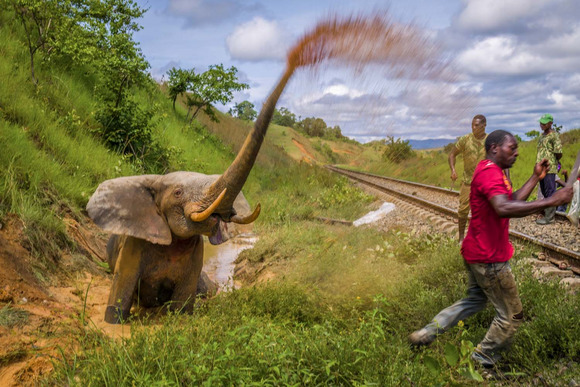FRITZ PÖLKING PRIZE AND FRITZ PÖLKING JUNIOR PRIZE 2023
The Fritz Pölking Junior Prize 2023 was awarded to Mateusz Piesiak for his portfolio about a Sunflower paradise for overwintering birds in his native country Poland.
Fritz Pölking Prize 2023

Jasper Doest | A fragile refuge for forest elephants
A fruit famine in one of the last strongholds of the African forest elephant raises concerns about the ability of this species and other fruit-dependent megafauna to survive in the long term... more...
Fritz Pölking Junior Prize 2023

Mateusz Piesiak | Sunflower paradise
A sunflower field could not be harvested because the soil was waterlogged after summer rains - a financial loss for the farmer, but the field became a true paradise for overwintering birds. more...
Jury commentary
by Britta Jaschinski (on behalf of the jury)
Awards like the Fritz Pölking Prize are instrumental in focussing attention on stories that would otherwise go untold. Whether it is the photographer's aim to reveal theimpact of humans on the planet or to highlight the beauty of nature, this award is an excellent opportunity to submit a story or portfolio to gain international recognition or draw attention to a specific issue, place or species.
In the words of this year’s adult winner, Jasper Doest:”I try to use photography to bridge the gap between the natural world and humanity.” In a society in which selfies of influencers, fake news and AI distort and overshadow reality, it is important that photographers are invitedto speak out and show us what is real and true.
It is the jury’s role to identify outstanding photographs -images that tell a story, that resonate with the viewer. This is no easy task. We viewed many excellent entries by photographers who put in a greatdeal of time and effort, often underpaid and sometimes even traumatised by their experiences. We were faced with the challenge to be fair and to come to a consensus amongst ourselves. Long, sometimes heated, debates ensued. However, all discussions were characterised by mutual respect, a willingness to listen, and an eagerness to learn from each other. If I may say so, it was a pleasure to be part of this jury. We all understood that selecting winners is a serious undertaking and not to be taken lightly. Sitting on the jury of such an important award is truly an intense process.
Knowing how hard the GDT team worked for this competition, we can trust that the winning images are not manipulated. Unfortunately, there are still photographers who submit images that have been altered. But thanks to strict controls, these entries can be identified and excluded from the competition. Although there is most definitely a place for manually retouched images and artificial intelligence photo editing, these practices will never replace photography and have no place in the Fritz Pölking Prize competition.
Some people say that taking photos is easy. Maybe so! But it is difficult to capture images that really matter. Only a small number of photographers have actually mastered this form of visual poetry -they possess the ability to capture a feeling, an atmosphere or a message that cannot be put into words. The power of photography lies in its ability to evoke emotions across language and cultural barriers. In many cases, thephotos and stories submitted for the Fritz Pölking Prize involved months or even years of research and preparation. The photographers had to learn as much as possible about their subjects, sometimes becoming experts on their species of interest. They had to choose the appropriate equipment, organise permits and travel, and deal with extreme weather conditions.
In Jasper Doest's compelling story A fragile refuge for forest elephants, we learn about the shortage of food in one of the last strongholds of the African forest elephant. The story, commissioned by National Geographic, raises concerns about the potential consequences for an entire ecosystem. It is a powerful reminder of the times we live in -an era in which human actions impact even the most remotecorners of our planet.
The photograph that most impressed the members of the jury depicts an elephant spraying a group of men with water. In my opinion, this photograph is an excellent example of Henri Cartier-Bresson's "decisive moment" -it captures themoment when all the elements in the image come together perfectly. A dramatic sequence of events unfolded directly in front of Jasper's lens, and he had to remind himself aloud that it was not his place to judge. We, as viewers, may also find ourselves jumping to judgement because we are unaware of our, albeit generally indirect, role as consumers in species decline and environmental destruction. This particular elephant, one of the few remaining representatives of an endangered species, suffered severe injuries when it was hit by a train carrying a valuable mineral that we all demand and consume.
Each time we travel by car or choose particular goods at the supermarket, we indirectly impact the fate of species and habitats. The Fritz Pölking Prize can serve as a vehicle for great storytellers to help bring people together who value and respect nature and thereby promote more harmonious coexistence.
This line of thinking also motivated the jury to select Sunflower paradiseby Mateusz Piesiak. The 2023 Fritz Pölking Junior Prize winner presents a highly creative endeavour. Seeing the world through Mateusz's lens gives us a glimpse of life reflected through the prism of the photographer's soul. Energy, rhythm, stillness, light, darkness, warmth and cold come together in a delightful manner that transports us beyond our surroundings to a very special place -a bird's paradise. By varying lenses, perspectives and angles, the photographer keeps us interested in and curious about a single sunflower field in Poland left unharvested after a local flooding event.
Putting together a portfolio with just the right balance of light, motifs and composition demands thought and talent. We were surprised at the large number of entries that met these criteria. But, in the end, it was Mateusz's story that convinced the jury. We hope that our choice inspires young photographers to continue taking pictures, to strive for excellence and to submit their portfolios to competitions in the future. At the end of the day, we are all dedicated to nurturing talent and celebrating the power of photography.








